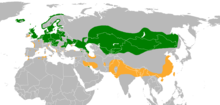Anser anser
| Greylag goose | |
|---|---|
 |
|
| Scientific classification | |
| Kingdom: | Animalia |
| Phylum: | Chordata |
| Class: | Aves |
| Order: | Anseriformes |
| Family: | Anatidae |
| Subfamily: | Anserinae |
| Tribe: | Anserini |
| Genus: | Anser |
| Species: | A. anser |
| Binomial name | |
|
Anser anser (Linnaeus, 1758) |
|
| Subspecies | |
|
|
 |
|
| Green: breeding, orange: non-breeding, red: introduced | |
| Synonyms | |
|
Anas anser Linnaeus, 1758 |
|
Anas anser Linnaeus, 1758
The greylag goose (Anser anser) is a bird in the waterfowl family Anatidae. It has mottled and barred grey and white plumage and an orange beak and legs. A large bird, it measures between 74 and 91 centimetres (29 and 36 in) in length, with an average weight of 3.3 kilograms (7.3 lb). Its distribution is widespread, with birds from the north of its range in Europe and Asia migrating southwards to spend the winter in warmer places. It is the type species of the genus Anser and is the ancestor of the domestic goose, having been domesticated at least as early as 1360 BC. The genus name is from anser, the Latin for "goose".
Greylag geese travel to their northerly breeding grounds in spring, nesting on moorlands, in marshes, around lakes and on coastal islands. They normally mate for life and nest on the ground among vegetation. A clutch of three to five eggs is laid; the female incubates the eggs and both parents defend and rear the young. The birds stay together as a family group, migrating southwards in autumn as part of a flock, and separating the following year. During the winter they occupy semi-aquatic habitats, estuaries, marshes and flooded fields, feeding on grass and often consuming agricultural crops.
Anser anser, the greylag goose, is a member of the waterfowl family Anatidae. It was first described by the Swedish naturalist Carl Linnaeus in 1758 as Anas anser, but was transferred two years later to the new genus Anser, erected by the French zoologist Mathurin Jacques Brisson, where it is the type species. Two subspecies are recognised; A. a. anser, the western greylag goose, breeds in Iceland and north and central Europe; A. a. rubrirostris, the eastern greylag goose, breeds in Romania, Turkey and Russia eastwards to northeastern China. The two subspecies intergrade where their ranges meet. The greylag goose sometimes hybridises with other species of goose including the barnacle goose (Branta leucopsis) and the Canada goose (Branta canadensis), and occasionally with the mute swan (Cygnus olor). The greylag goose was one of the first animals to be domesticated; this happened at least 3000 years ago in Ancient Egypt, the domestic breed being known as A. a. domesticus. As the domestic goose is a subspecies of the greylag goose they are able to interbreed, with the offspring sharing characteristics of both the wild and tame birds.
...
Wikipedia

